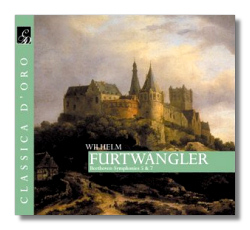
The Internet's Premier Classical Music Source
Related Links
-
J.S. Bach Reviews
Beethoven Reviews
Bruckner Reviews
Tchaikovsky Reviews - Latest Reviews
- More Reviews
-
By Composer
-
Collections
DVD & Blu-ray
Books
Concert Reviews
Articles/Interviews
Software
Audio
Search Amazon
Recommended Links
Site News
 CD Review
CD Review
The Meaning of Recordings

Stokowski Conducts Bach Transcriptions (1927-40)
- Johann Sebastian Bach:
- Toccata & Fugue in D minor, BWV 565
- Prelude in E minor
- Air
- Sarabande
- Siciliano
- Mein Jesu! Was für Seelenweh, BWV 487
- Es ist vollbracht
- Christ lag in Todesbanden
- O Haupt voll Blut
- Komm, süßer Tod, BWV 478
- Passacaglia & Fugue in C minor, BWV 582
Philadelphia Orchestra/Leopold Stokowski
Classica D'Oro 1011


Stokowski Conducts Tchaikovsky
- Piotr Ilyitch Tchaikovsky:
- Symphony #4 in F minor, Op. 36
- Symphony #5 in E minor, Op. 64 *
- Fantasy Overture in B minor "Roméo & Juliet"
- Marche Slav, Op. 31
NBC Symphony Orchestra/Leopold Stokowski
* Philadelphia Orchestra/Leopold Stokowski
Classica D'Oro 1012 2CDs


Furtwängler Conducts Beethoven (1943)
- Ludwig van Beethoven:
- Symphony #5 in C minor, Op. 67
- Symphony #7 in A Major, Op. 92
Berlin Philharmonic Orchestra/Wilhelm Furtwängler
Classica D'Oro 1002 (Also #'s 4 and 9 on Good International 2050) 2CDs


Furtwängler Conducts Bruckner (1942)
- Anton Bruckner:
- Symphony #5
Berlin Philharmonic Orchestra/Wilhelm Furtwängler
Classica D'Oro 1023
Also consulted, Stokowski: Bach Transcriptions (Pearl 1836); Tchaikovsky: Symphony #4 (Cala 505); Tchaikovsky: Symphony #5 (Biddulph 015). Also consulted, Furtwängler in Bruckner's 5th (DG 427774)
Since copyrights have expired on all of these recordings, and since there is a market, no matter its size, for older recordings, almost everyone in town is playing the game. Where do the masters come from that are used? More than likely from Pearl, Biddulph and Cala in the case of the Stokowski. In the case of Furtwängler I am not as sure, but Music and Arts is certainly a likely source. On the other hand, the Bruckner was surely from DGs release. From the flood represented in this article, I can recommend fully only two. Reasons follow.
The D'Oro label has issued several operas already in their efforts. Their set of Furtwängler's 1950 La Scala "Ring" excellent. The sound was clear, detailed and had depth and warmth as well. So it was with interest that I ordered the above items. (Fred Maroth, head of Music and Arts, told me that D'Oro "stole" his transfers to make their set. More than likely, however, they bought the original CDs, maybe even from Fred, and didn't steal anything. After all, all they have to do is add a bit of Cedaring, some reverb, cut it at a higher or lower level, any or all of the above, and they have their "own" remastering. Ta..dah!)
When you add the "Good International" set… well it gets peculiarer and peculiarer. This means that the customer really has no clue as to the quality of what s/he is buying unless they read articles like this. As a result, many of them skip it altogether and that has its consequences, too. So, as part of an experiment for my theory on feedback, I actually purchased the discs from D'Oro and G/I and will now report the results.
First, let's get the bad out of the way. Insert notes for the Classica series are short and often error riddled. In addition, the author makes questionable statements. Of the Stokowski/Bach recordings Mr. Cosentino states, "Stokowski's biggest moment of fame came in 1940, when he bent down from his Olympian podium to shake hands with Mickey Mouse at the beginning of Walt Disney's Fantasia." At the beginning? Biggest moment of fame? What about the U.S. première of Stravinsky's "Rite" which landed Stokowski on the cover of Time? Elsewhere he refers to Stokowski as the "Oz of the magnificent Philadelphia Orchestra". On the other hand, he does offer a pretty good description of the Bach transcriptions, "brooding romanticism and mystical overtones summoned up primal emotions heretofore untapped in Bach's music…" The prose is purple. The notes for the G/I Furtwängler release are in Japanese on one disc and in the other comments like this are offered, "In 1949 he was appointed conductor of the hostility of public opinion in America." What is that supposed to mean?
As for the recordings, there is more bad news. Both the Classica and G/I releases have a pause before the final movement of the Beethoven 5th Symphony. On the former it is 4 seconds and on the latter it is two. What is that all about? It certainly ruins the effect. I tried to contact Allegro, who is listed as the source of Classica, to ask if there was any plans to correct the problem on their release. I went to the web site cited on the back of the CD and it is not correct. After a search and an email, I did locate the Allegro corporation that does distribute the label. I have emailed them inquiring about the series and if the problem with the 5th will be remedied. At this point I have had no answer. As for the symphonies of Tchaikovsky, both suffer from problems. The Fourth Symphony is remastered as a higher level than the Cala release. The result is too bright. The Cala is warmer but still detailed. The Fifth Symphony comes from a source that is off pitch. The opening woodwinds sound awful. This is not the case in the Biddulph release.
Now, come comparisons. The G/I is typical of most historic releases. The sound is okay and Cedaring has reduced some surface noise. Still, in comparison with the Classica, the more distant, lower level of transfer obscures detail and reduces the impact of the music. While I am glad I have added the 4th and "Pastorale" to my collection of Furtwängler recordings, it is only a stopgap. Finally, the timings on the 4th and 7th Symphonies are reversed in the notes, but so are the recordings. In a phrase, avoid this release.
The Classica series is much more musical, with the noted exceptions of the Tchaikovsky. The general procedure they follow is to transfer the music at a higher level and add reverberation. The result offers more detail and a deeper, richer sound than other releases. I would recommend the Bach and Bruckner especially if you already have the other incarnations. The Toccata and Fugue has the best sound I have heard. You can really hear the double basses dig into the music, an element not as clear as in the Pearl. On the other hand, the Bach does omit the Chaconne, my favorite Stokowski/Bach piece. The Furtwängler Beethoven disc is marvelous and, as I mentioned, I have tried to see if they plan to correct the problem. The sound on both is fantastic and involves you NOW. By comparison, the G/I is emotionally flat. It makes you wonder if it is the same recording.
The Classica Bruckner offers the same improvements over the previous release on DG. A higher level of transfer and added reverberation provides a more compelling listening experience. To cite but one instance, at 4:20 into the first movement the lower strings play a pizzicato that is clear and almost tactile in the Classica whereas you have to really listen to hear it in the DG release. The music is different.
Now, what does all of this "mean"? What follows is philosophic in nature, and essence, and this is the warning to those who wish to skip it and simply make what purchases they wish.
Al Franz, an old friend of mine, was a dedicated LP fan. He invested in the finest equipment around to play those records. Whenever I'd visit he'd put them on and hand me his headphones so I could "hear" how good they were. He used to say, "There's more music in those grooves than we used to hear. This brings it out." I miss Al.
Anyway, his comments are certainly apt in this case. Obviously there is "more music" coming from some source. I doubt it is from the original LPs, however, because that would be more expensive than companies like Classica (whoever they are) are likely to spend. It is also obvious that cutting masters at a higher level brings out more music. On the other hand, sometimes it also produces a pitch that I find intolerable after a few moments, such as in the Stokowski/Tchaikovsky mentioned above. Merely increasing the volume of the older releases doesn't produce the same musical effect. On the other hand, an echat with Mark (Transfrguy) Obert-Thorn was educational about what can be done. In fact, they can transfer a different CD at a higher level and by adding de-noising, as well as Cedaring, the consequence is a much different recording. Mark told me about a time he sent a recording in for de-noising and the disc he was sent back had an impact that was not in the master he sent. Whatever.
Here is the point, how a recording means is what it means. When you listen to any recording the recording itself is part of the process. That means that to separate the process into parts misses the whole point. It is asking the wrong question. How a recording means is another instance, or proof, that feedback is what holds it all together.
That is, your perception and appreciation of any given recording will have a lot to do with the quality of the middleman, the medium. The ear of the producer, and perhaps just happenstance, can affect your appreciation because it affects your perception. Ergo, the "it" outside of you also is engaged in a feedback with the "it" which is your "self".
Post Script: I recently picked up two more Classica D'Oro discs. One contains Furtwängler's 1944 Vienna Bruckner 8th. The other's main course is Brahms 4th from 1948 with the Berlin Philharmonic. The Brahms suffers from the pitch problem alluded to above. The Bruckner is less worse, but still gets on my ear's nerves after a bit. On the other hand, it is a hell of a performance.
Copyright © 2002, Robert Stumpf II


















